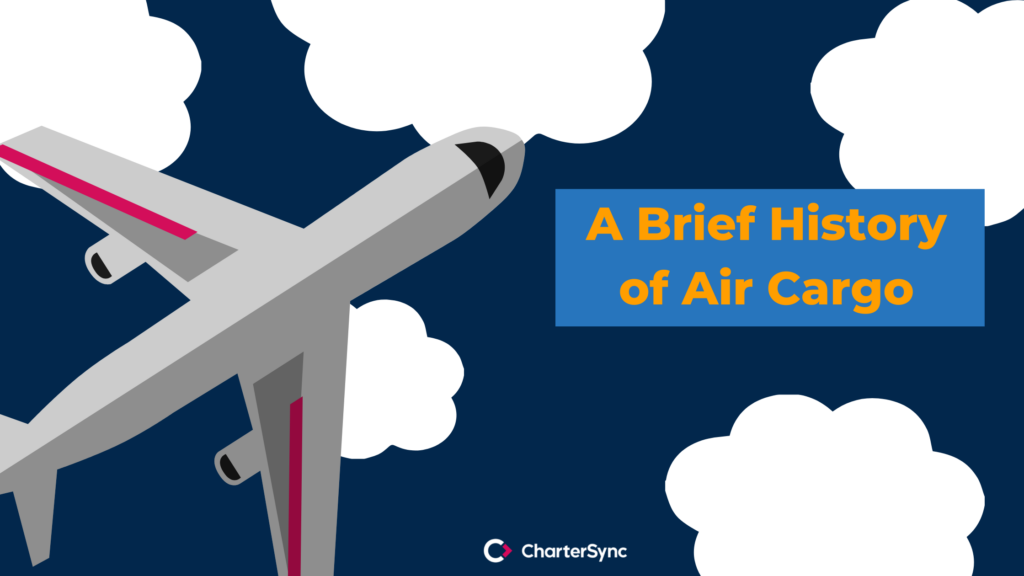Air Cargo
A Brief History of Air Cargo

The air freight industry is a vital part of the logistics sector and critical element of supply chain management for companies in all sectors across the globe.
Pre-pandemic in 2018, the International Air Transportation Association (IATA) forecasted that air cargo would carry an estimated 62.5 million tonnes, with the value of goods expected to be $6.2 trillion (USD), equivalent to 7.4% of the world’s GDP. Despite the COVID-19 pandemic, IATA published a report in March 2022 that showed global demand for air cargo was up 2.7% from the same month in the previous year, and in December 2021, rose 9.3%.
Many would imagine air cargo to be a relatively recent development within the transportation of goods. In fact, the developmental timeline is still significantly shorter than more traditional methods such as sea freight. However, air freight began sooner than most would predict, over 110 years ago in 1910!
Aviation Begins
On 17th December 1903, Orville and Wilbur Wright, two brothers considered pioneers in aviation, flew their first aircraft dubbed the “Wright Flyer I”, for the first time, which also marked the first powered flight with a passenger. After this journey, the Wright brothers made some alterations and invested in the design of the “Wright Model B”, also known as the first “freighter” aircraft.
Less than 7 years later on 7th November 1910, the Wright brothers took to the skies with the first air freight flight recorded. The aircraft carried 200lbs of silk on a 65-mile interstate journey from Dayton to Columbus, Ohio, for the grand opening of a department store. This first flight was no mere delivery either, it was also a race, pitting air freight against an express train. We’ll let you guess which won…
Evidently, aircraft at this time were small and not powerful, large enough or sturdy enough to carry much cargo. The primary use initially was for airmail, carrying letters and small packages. By 1914, the United States was regularly using air freight to deliver mail, and by 1930, domestic airmail contracts accounted for 85% of US airline revenue. Airmail first entered Great Britain in 1911. However, it was halted after 16 flights due to severe delays from the weather.
Between the Wars
During World War I, aircraft were still new and were only marginally used due to a lack of technology. They saw the potential, however, and pilots and aviation enthusiasts sought to make aircraft commercially viable, and many nations convinced their military to fund the expansion of aircraft as a matter of urgency. By World War II, enormous advances had been made. Flight proved to be the fastest way of transporting troops, medical supplies and weaponry. Despite the advances already made, WWII drove further progress in aircraft technology and lead the way for jet engines to enter into mass production.
Introduction of IATA
The International Air Transport Association was established in Havana, Cuba in April 1945. It is the successor to the International Air Traffic Association founded in the Hague in 1919. IATA is the trade association for the worlds’ airlines. At its founding, there were 57 members from 31 nations. Today, they represent 290 airlines from 120 nations.
The 1960s – 2000s
A major advancement for aircraft and therefore, air freight, occurred in 1968 when Boeing brought the first widebody aircraft, a four-engine 747, to market. This marked the first aircraft that was able to transport full-sized pallets in the hold, which revolutionised the air cargo industry.
Another revolutionary milestone occurred in the mid-1970s when Fred Smith founded Federal Express, or FedEx as we know it today. Smith convinced a number of investors that combining passenger air services with freight was inefficient, claiming it slowed down the movement of cargo. Federal Express was profitable within three years, and within 10 years of its founding, had revenues of over $1 billion USD.
Express Delivery
United Postal Service (UPS) has also had a dominant role in the air freight and airmail sectors. UPS traces back to bicycle-based delivery services, which began in 1907. They started an air freight service in 1929, but it wasn’t profitable until 1953. Following this, in 1988 UPS sought permission from the FAA to operate its own airline instead of always leasing aircraft. They named it UPS Airline. By 2001, UPS was the ninth-largest US airline.
Because of the rise of companies such as FedEx, UPS, DHL and TNT offering express delivery, air freight grew significantly during the 1990s. Technological advances have meant increased air freight has generated greater traffic. In 1992, FedEx was the first company to provide parcel tracking services to their customers. This software increased air freight frequency. What fuelled the most growth of air cargo demand was global e-commerce, and the ability to move goods from one country to another.
If you’re interested in learning more about CharterSync, get in touch! Our friendly, world-class sales and operations team are on hand 24/7 to offer round-the-clock support.

NEWSLETTER